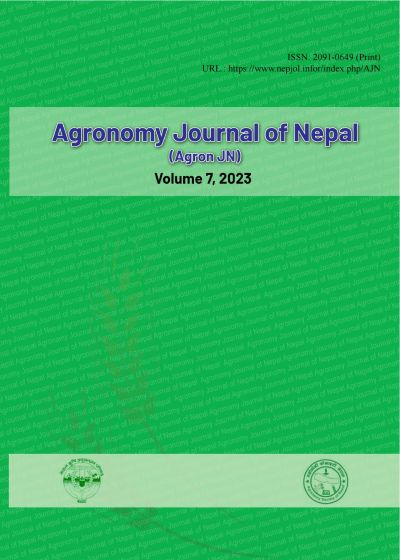Performance of Promising Rice Genotypes as Affected by Different Nitrogen Levels in Central Terai of Nepal
DOI:
https://doi.org/10.3126/ajn.v7i1.62165Keywords:
Agronomic nitrogen use efficiency, grain yield, nitrogen levels, rice genotypesAbstract
Application of appropriate level of nitrogen (N) for rice is a key to increase nitrogen use efficiency thereby yields. Six rice genotypes under six N levels were evaluated in a split plot design with three replications under irrigated conditions in National Rice Research Program, Dhanusha during 2020 with the objective of determining the high yielding variety and the best dose of N for obtaining higher yield. The six rice genotypes were NR 2168, NR 2158, NR 2157-122, NR 2175, NR 2182 and PR 126 while various N levels were 0. 75, 100, 125, 150 and 175 kg N ha-1. The results indicated that NR 2182 recorded the highest grain yield of 5.28 t ha-1 while PR 126 recorded the lowest grain yield 3.98 t ha-1. A linear increase in grain yield was observed with a continuous increase in N level from 0 to 150 kg ha-1 while it decreased thereafter. The grain yield was significantly higher with the application of 150 kg N ha-1 as compared to control. Agronomic N use efficiency for studied rice genotypes varied significantly and ranged from negative to 12.63 kg grain yield per kg of N applied. NR 2182 recorded the highest value of agronomic nitrogen use efficiency for the N level of 150 kg ha-1. It can be concluded that increasing nitrogen levels resulted in significant variations in the response of different varieties, with all varieties consistently recording lower yields at highest N levels. Thus, opting for an intermediate N level appears both economically prudent and environmentally sustainable.
Downloads
Downloads
Published
How to Cite
Issue
Section
License
Copyright (c) 2023 Agronomy Society of Nepal (ASoN)

This work is licensed under a Creative Commons Attribution-NonCommercial 4.0 International License.
ASON permits for free use, distribution and reproduction in any medium if the original work is properly cited and not used for commercial purposes.




